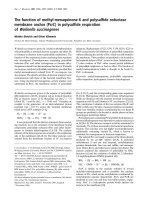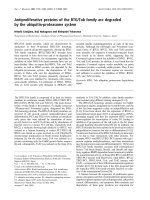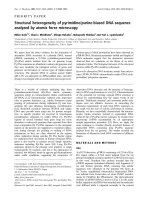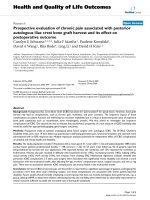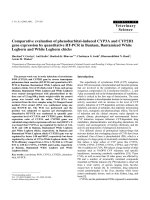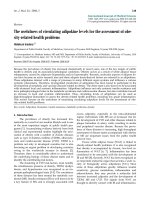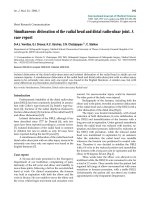Báo cáo y học: "Prospective evaluation of serum biomarker levels and cartilage repair by autologous chondrocyte transplantation and subchondral drilling in a canine model" pps
Bạn đang xem bản rút gọn của tài liệu. Xem và tải ngay bản đầy đủ của tài liệu tại đây (882.79 KB, 9 trang )
Open Access
Available online />Page 1 of 9
(page number not for citation purposes)
Vol 11 No 3
Research article
Prospective evaluation of serum biomarker levels and cartilage
repair by autologous chondrocyte transplantation and
subchondral drilling in a canine model
Korakot Nganvongpanit
1
*, Peraphan Pothacharoen
2
*, Patama Chaochird
1
, Kasisin Klunklin
3
,
Kanawee Warrit
4
, Jongkolnee Settakorn
5
, Nuttaya Pattamapaspong
6
, Sirichai Luevitoonvechkij
3
,
Olarn Arpornchayanon
3
, Prachya Kongtawelert
2
and Dumnoensun Pruksakorn
3
*
1
Bone and Joint Research Laboratory, Department of Veterinary Bioscience and Public Health, Faculty of Veterinary Medicine, Chiang Mai University,
Kanklongchonpratan Road, Chiang Mai, 50100, Thailand
2
Thailand Excellence Centre for Tissue Engineering, Department of Biochemistry, Faculty of Medicine, Chiang Mai University, Suthep Road, Chiang
Mai, 50200, Thailand
3
Musculoskeletal Research Laboratory, Department of Orthopedics, Faculty of Medicine, Chiang Mai University, Suthep Road, Chiang Mai, 50200,
Thailand
4
Department of Companion Animals and Wild Life, Faculty of Veterinary Medicine, Chiang Mai University, Kanklongchonpratan Road, Chiang Mai,
50100, Thailand
5
Department of Pathology, Faculty of Medicine, Chiang Mai University, Suthep Road, Chiang Mai, 50200, Thailand
6
Department of Radiology, Faculty of Medicine, Chiang Mai University, Suthep Road, Chiang Mai, 50200, Thailand
* Contributed equally
Corresponding author: Dumnoensun Pruksakorn,
Received: 24 Dec 2008 Revisions requested: 3 Feb 2009 Revisions received: 2 May 2009 Accepted: 26 May 2009 Published: 26 May 2009
Arthritis Research & Therapy 2009, 11:R78 (doi:10.1186/ar2709)
This article is online at: />© 2009 Nganvongpanit et al.; licensee BioMed Central Ltd.
This is an open access article distributed under the terms of the Creative Commons Attribution License ( />),
which permits unrestricted use, distribution, and reproduction in any medium, provided the original work is properly cited.
Abstract
Introduction The purpose of this study was to evaluate serum
chondroitin sulfate (CS) and hyaluronic acid (HA) levels and the
capability of cartilage repair of full-thickness cartilage defects
after treatment with two different fundamental surgical
techniques: autologous chondrocyte transplantation (AC) and
subchondral drilling (SD).
Methods A 4-mm-diameter full-thickness cartilage defect was
created in each of 10 skeletally mature male outbred dogs. The
dogs were randomly separated into two groups. Groups A and
B were treated with AC and SD, respectively. An evaluation was
made at the 24th week of the experiment. Serum was analyzed
prospectively – preoperatively and at 6-week intervals – for CS
and HA levels by enzyme-linked immunosorbent assay (ELISA)
and ELISA-based assays, respectively.
Results The cartilage repair assessment score (median ±
standard deviation) of group A (9.5 ± 2.5) was significantly
higher than that of group B (2.5 ± 1.3) (P < 0.05). Group A also
demonstrated a better quality of hyaline-like cartilage repair.
Prospective analysis of serum WF6 and HA levels between the
two groups did not show any significant difference. Serum WF6
levels at the 24th week of the experiment had a negative
correlation (r = -0.69, P < 0.05) with the cartilage repair
assessment score, whereas serum HA levels tended to
correlate positively (r = 0.46, 0.1 <P < 0.05).
Conclusions AC treatment provides superior results to SD
treatment, according to morphology, histology, and cartilage
marker levels. AC treatment demonstrated a smoother surface,
less fissure, better border integration, and a more reliable
outcome of repairing cartilage. Moreover, a decreasing level of
serum WF6, which correlated with good quality of the repairing
tissue at the end of the follow-up period, was found
predominantly in the AC group. Serum WF6 therefore should be
further explored as a sensitive marker for the noninvasive
therapeutic evaluation of cartilage repair procedures.
AC: autologous chondrocyte transplantation; BSA: bovine serum albumin; CS: chondroitin sulfate; D1 to 10: dog number 1 to 10; DMEM: Dulbecco's
modified Eagle's medium; EDTA: ethylenediaminetetraacetic acid; ELISA: enzyme-linked immunosorbent assay; HA: hyaluronic acid; ICRS: Interna-
tional Cartilage Repair Society; o-PD: ortho-phenylenediamine; PBS: phosphate-buffered saline; SD: subchondral drilling.
Arthritis Research & Therapy Vol 11 No 3 Nganvongpanit et al.
Page 2 of 9
(page number not for citation purposes)
Introduction
Due to a lack of effective monitoring methods after treatment,
the optimal treatment for cartilage lesions has not been estab-
lished. Although cartilage repair procedures – based on mar-
row-stimulating techniques such as subchondral drilling (SD),
microfracture, and abrasion chondroplasty – provided initially
favorable results, inferior fibrocartilage healing could lead to
osteoarthritis in the long term [1]. Over the past decade, autol-
ogous chondrocyte transplantation (AC) has challenged previ-
ous techniques. Hyaline-like cartilage tissue was produced
after treatment, as reported in several studies [2-6]. To deter-
mine the quality of cartilage repair and predict the long-term
results, a noninvasive method that can be objectively inter-
preted and that is available for long-term application would be
of great assistance. Serum biomarkers, which have been
widely studied in the treatment of many musculoskeletal dis-
eases, might be one of the most promising tools that could be
used for such purposes. Herein, we prospectively analyzed
serum chondroitin sulfate (CS) and hyaluronic acid (HA) levels
using monoclonal antibody WF6 and enzyme-linked immuno-
sorbent assay (ELISA), respectively, accompanying the carti-
lage repair assessment of two distinct fundamental surgical
techniques: cell-based therapy (AC) and marrow-stimulating
technique (SD).
Materials and methods
Animal model
Ten skeletally mature adult male outbred dogs, each weighing
approximately 11 to 15 kg, were used in the study. Prior to
recruitment, their knee joints were investigated using magnetic
resonance imaging to exclude animals with degenerative joint
disease or other orthopedic problems. The experimental pro-
tocol was approved by the Faculty of Veterinary Medicine and
the ethics committee of Chiang Mai University, Thailand.
Animals were randomly separated into two groups. Group A
was treated with AC, and group B was treated with SD. All
operations were performed on the knee joint, with the animal
under anesthesia and in sterile conditions. A prophylactic anti-
biotic (cephalexin) and an anti-inflammatory drug (vedaprofen;
Intervet, Bangkok, Thailand) were given intravenously in three
doses over the course of a 24-hour period during and after
surgery. Both groups of animals were operated on three times.
Full-thickness cartilage defect creation and cartilage harvest-
ing were performed simultaneously. AC or SD was carried out
over the following 4 weeks. All animals underwent arthrotomy
and core biopsy at the 24th week of the experiment (the 20th
week after treatment) for final evaluation. All animals were kept
for phase II experiments.
For the cartilage harvesting procedure, the right knee joint was
opened by an anteromedial approach. A 4-mm-diameter artic-
ular cartilage defect was created at the medial side of the tro-
chlea of the femur by means of a 4-mm-diameter dermal punch
to outline the defect. A customized curette was used to scrape
all cartilage to the zone of calcified cartilage in both groups.
Chondrocytes were isolated from the shavings and cultured as
described below. Animals were allowed unrestricted cage
activity after surgery.
At the fourth week, group A (n = 5) was treated with AC. The
cartilage defect was covered with a periosteal flap (with the
cambium layer facing toward the bone), which had been har-
vested from the proximal tibia. The flap was sutured to the sur-
rounding rim of the normal cartilage with interrupted 8-0
sutures, and the surrounding edge was sealed with fibrin glue
(FibrinGluRAAS, Shanghai RAAS Blood Products Co. Ltd.,
Shanghai, China). Cultured chondrocytes in culture medium
(2 × 10
6
cells per defect) were injected beneath the periosteal
flap. Group B (n = 5) was treated with SD. The cartilage
defect was treated by using a 1.2-mm drill to create three drill
holes. Before the joint was closed, bleeding vessels were cau-
terized and the patella was relocated. The joint was closed and
the knee immobilized by a bulky soft splint for 1 week and a
partial splint for 1 additional week. The splints and stitches
were removed at the end of the second week, after which all
animals were allowed to ambulate normally until the end of the
experiment [4-6]. Cartilage removal in both groups and the
covering of the defect with periosteum in group A were per-
formed under loupe visualization.
Isolation and culture of chondrocyte
Articular cartilage chondrocytes were isolated from the femo-
ral trochlea as previously described [7]. Briefly, chondrocytes
were isolated by digestion with 0.2% type II collagenase for
16 hours and resuspended in Dulbecco's modified Eagle's
medium (DMEM) (Gibco, now part of Invitrogen Corporation,
Carlsbad, CA, USA) containing 100 units/mL penicillin and
100 units/mL streptomycin. Chondrocytes were plated in tis-
sue culture flasks at 10
4
cells per square centimeter and cul-
tured in DMEM/F-12 supplemented with 10% heat-inactivated
fetal bovine serum (Invitrogen Corporation) at 37°C in a
humidified atmosphere of 5% carbon dioxide and 95% air.
After 10 days, when cells had reached subconfluence, the
passage-1 cells were detached by treatment with 0.25%
trypsin/1 mM ethylenediaminetetraacetic acid (EDTA) and
plated at 5 × 10
3
cells per square centimeter. Chondrocytes
from second passages were used in the following experi-
ments.
Biomarker assay
Serum was obtained from both groups. The first sample was
started at the first date of the first week of the experiment
before the first operation and the subsequent samples were
taken every 6 weeks until the end of the experiment (a total of
24 weeks of experiment or 20 weeks of postoperative follow-
up). Serum was centrifuged at 6,500 g for 10 minutes. Super-
natants were stored at -80°C until assay.
Available online />Page 3 of 9
(page number not for citation purposes)
Competitive immunoassay using monoclonal antibody
WF6
A mouse monoclonal antibody WF6 was raised against a
shark cartilage aggrecan preparation [8], and a quantitative
ELISA for the epitope recognized by monoclonal antibody
WF6 was modified from a previous study [9]. The antibody
was specific for intact CS chains and showed no interaction
with other sulfated glycosaminoglycans, hyaluronan, or other
polyanions, such as DNA, RNA, or dextran sulfate [9]. The
standard used in the assay was shark cartilage aggrecan (A1
fraction) at concentrations of 19 to 10,000 ng/mL in 6%
bovine serum albumin (BSA) in Tris-incubating buffer (0.1 M
Tris HCl, pH 7.4, containing 0.15 M sodium chloride, 0.1%
Tween 20 and 0.1% BSA). Diluted human serum samples (1:5
in 6% BSA-Tris-incubating buffer) were added to 1.5-mL plas-
tic tubes containing an equal volume of WF6 (cell culture
supernatant, 1:200 dilution in Tris-incubatingbuffer). They
were incubated at 37°C for 1 hour and added to the microtiter
plate, which was precoated with shark aggrecan (A1 fraction).
Nonspecific protein binding was blocked with BSA. The plates
were incubated at 37°C for 1 hour, the wells were washed,
and peroxidase-conjugated anti-mouse IgM antibody
(1:2,000) was added (100 mL/well in Tris-incubating buffer).
The bound conjugate was detected by adding ortho-phenylen-
ediamine (o-PD) substrate (100 mL/well in 0.05 M citrate
buffer, pH 5.0). The reaction was stopped after 10 minutes
with 50 mL/well of 4 M sulfuric acid, and absorbance was
determined using a microplate reader at 492/690 nm. The
concentration of WF6 epitope in supernatant samples was
calculated by reference to a standard curve.
Enzyme-linked immunosorbent assay-based assay for
hyaluronic acid (HA) using biotinylated HA-binding
proteins
Human serum samples or standard HA (HealonR) at various
concentrations (19 to 10,000 ng/mL in 6% BSA-phosphate-
buffered saline [BSA-PBS], pH 7.4) was added to 1.5-mL
plastic tubes containing biotinylated HA-binding proteins
(HABPs) prepared as described above (1:200 in 0.05 M Tris-
HCl buffer, pH 8.6). The tubes were incubated at room tem-
perature for 1 hour, and samples were added to the micro-
plate, which was precoated with umbilical cord HA (100 mL/
well of 10 mg/mL) and blocked with 1% BSA (150 mL/well).
The plate was incubated at room temperature for 1 hour. The
wells were washed, and peroxidase-conjugated antibiotin anti-
body (1:2,000 dilution), 100 mL/well in PBS, was added. The
plate was incubated at room temperature for another hour. The
detection of conjugated antibody was with o-PD substrate,
and plate reading was carried out as described above. The
concentration of HA in samples was calculated from the
standard curve [8,10].
Tissue preparation
At the 24th week of the experiment, repaired tissues were
examined grossly and photographically. Normal cartilage and
repaired cartilage were harvested by using 5-mm-diameter
custom-made core biopsies. Tissue was placed in 10% neu-
tral buffered formalin. Each sample was placed into 15% dis-
odium EDTA decalcifying solution (pH 7.4) and shaken at 4°C.
Decalcifying solution was changed three times each week for
4 weeks. The specimens were rinsed thoroughly, dehydrated,
and embedded in paraffin at 60°C. Seven-micrometer-thick
sections were prepared and were stained with hematoxylin
and eosin and with Safranin O for microscopic examination of
the repaired tissue [10].
Histology evaluation
At the 24th week of the experiment, the quality of the repaired
tissue was evaluated by two methods. Repaired cartilage was
blindly evaluated by orthopedic surgeons intraoperatively.
Lesions were graded for the extent of cartilage repair accord-
ing to the cartilage repair assessment from the International
Cartilage Repair Society (ICRS) Cartilage Injury Evaluation
Package [11]. Histological sections from each animal were
scored by a pathologist according to (a) surface, (b) matrix, (c)
cell distribution, (d) cell population viability, (e) subchondral
bone, and (f) cartilage mineralization, using the ICRS Visual
Histological Assessment Scale [12].
Statistical analysis
The general identification information and cartilage score
assessment (ICRS Cartilage Injury Evaluation Package) of the
two groups were analyzed by means of the Student t test.
Quantitative data of serum WF6 and HA were analyzed by a
nonparametric Wilcoxon rank sum test. All data were consid-
ered significant when P values were less than 0.05. The cor-
relation between serum WF6 and HA levels and the cartilage
score assessment was analyzed by means of the Kendall rank
correlation coefficient test. All statistical analysis was per-
formed with STATA software version 10.0 (StataCorp LP, Col-
lege Station, TX, USA).
Results
General information about all animals, including age, gender,
weight, and basic biochemistry laboratory findings, is shown in
Table 1. All 10 canines ambulated normally after splint
removal, and there were no infections or complications during
postoperative monitoring through the 24th week of the exper-
iment. At the time of the final operation, all synovial tissue
appeared normal. Joint fluid was within a normal range, with
some slightly wetter or drier.
Cartilage repair evaluation
As shown in Table 2, for the AC group, dog number 1 (D1)
shows normal repaired cartilage tissue; D2, D4, and D5 show
nearly normal results; and D3 showed abnormal repair, with
50% filling of repaired cartilage and approximately half of the
repaired cartilage integrated with the normal cartilage border.
On the other hand, most of the SD group showed poorer
results. D6, D8, and D9 presented total degeneration of the
Arthritis Research & Therapy Vol 11 No 3 Nganvongpanit et al.
Page 4 of 9
(page number not for citation purposes)
repair site, with further degeneration of the surrounding normal
hyaline cartilage. D7 and D10 showed repairing tissue around
the drilling holes, with velvet surface appearance and signifi-
cant separation of the repair site (depending on the drilling
hole) without continuity of the normal cartilage border. The
scores of cartilage repair (mean ± standard deviation) were
significantly higher in the AC group: 9.4 ± 2.3 for AC versus
2.0 ± 1.0 for SD (P < 0.05) (Figure 1).
Histology evaluation
Cartilage tissue of the AC group demonstrated a more colum-
nar arrangement of cell distribution and was mostly a mix of
hyaline/fibrocartilage-like matrix. Despite an increasing cell
population viability in the SD group, the matrix appeared pre-
dominantly in the fibrous tissue or fibrocartilage-like matrix,
corresponding to the velvet surface repair in macroscopic
appearance. Subchondral bone characterization and cartilage
mineralization in AC showed a better remodeling result than
that of SD (Figures 2 and 3; Table 3)
Serum cartilage marker evaluation
Serum WF6 levels of all animals progressed to higher levels
during the 6th and 12th weeks in comparison with the preop-
erative level and slightly decreased during the 18th and 24th
weeks in the AC group; however, those changes did not dem-
onstrate a statistically significant difference between the two
treatment groups (Figure 4a). On the other hand, serum HA
level presented more variability than serum WF6 level, and the
result progressively decreased from preoperative levels for
both treatment groups. Serum HA level also did not show a
significant difference in prospective follow-up between the
two groups (Figure 4b). By cross-sectional analysis of mark-
ers, serum WF6 level at the 24th week of the experiment
showed a negative correlation with the cartilage repair assess-
ment score (r = -0.69, P < 0.05), whereas serum HA level
tended to present a positive correlation (r = 0.46, 0.1 <P <
0.05) (Figure 5).
Table 1
Identification data of animals
Parameter AC (n = 5)
a
95% CI SD (n = 5)
a
95% CI P value
Gender Male - Male - -
Age (month) 40 ± 15 21.4–58.6 38 ± 16 18.1–57.9 0.844
Weight (kg) 14.1 ± 0.8 13.1–15.1 13.1 ± 2.1 10.5–15.7 0.356
BUN (mg/dL) 13.7 ± 3.1 9.9–17.5 14.3 ± 3.9 9.5–19.1 0.793
Cr (mg/dL) 1.1 ± 0.11 0.9–1.2 1.0 ± 0.1 0.8–1.2 0.581
AST (IU/L) 31.0 ± 13.5 14.2–47.8 31.0 ± 9.3 19.5–42.5 1.000
ALT (U/L) 20.0 ± 4.5 14.4–25.6 25.4 ± 5.9 18.1–32.7 0.142
Hemoglobin (g/dL) 13.8 ± 1.8 11.6–16.1 13.6 ± 1.9 11.2–15.9 0.817
White blood cells (/μL) 10,560.0 ± 1,705.3 8,442.6–12,677.4 9,870.0 ± 1,284.3 8,275.3–11,464.7 0.490
The two groups show similar baseline characteristics.
a
Values are the mean ± standard deviation. AC, autologous chondrocyte transplantation;
ALT, alanine aminotransferase; AST, aspartate aminotransferase; BUN, blood urea nitrogen; CI, confidence interval; Cr, creatinine; SD,
subchondral drilling.
Table 2
Morphological evaluation of the treatment using Cartilage Repair Assessment (ICRS Cartilage Injury Evaluation Package) [11]
Parameters Autologous chondrocyte transplantation Subchondral drilling
D1 D2 D3 D4 D5 D6 D7 D8 D9 D10
Degree of defect repair 4 2 2 4 3 0321 3
Integration of border zone 4 3 1 4 3 0000 0
Macroscopic appearance 4 4 3 3 3 1000 0
Overall assessment 12 9 6 11 9 1321 3
Grade I II III II II IV III III IV III
D1, D2, and so on refer to dog number 1, dog number 2, and so on. ICRS, International Cartilage Repair Society.
Available online />Page 5 of 9
(page number not for citation purposes)
Discussion
We prospectively studied two distinct fundamental surgical
techniques for cartilage treatment. For the AC group, cultured
chondrocytes were injected under the periosteal flap sutured
over the defect; this retains the injected cells, and the cam-
bium layer participates in the process of chondrogenesis
[6,13]. SD, a traditional cartilage defect treatment, was per-
formed by penetrating the subchondral bone; this facilitates
the migration of the injected cells, as first reported by Pridie in
1959. This method has been widely used for osteoarthritis and
cartilage defect treatment since it is an easy surgical tech-
nique and improves the initial clinical outcome [14].
In this study, the AC technique demonstrated obviously better
results than the SD technique, including smooth surface, bor-
der integration, and reliable tissue repair. The periosteum cov-
ering technique not only provides an initially smooth texture
outline for the chondrocytes but also enhances differentiation
and proliferative potential for the new repairing tissue, as has
been reported previously [6,15]. The liquidity of the autolo-
gous chondrocyte solution can fill in any shape of defect,
regardless of size and depth; therefore, the repairing tissue
demonstrates good integration of normal cartilage border and
fewer problems of cartilage fissure as opposed to SD tech-
niques. The repairing process in the AC group doubly bene-
fited from two factors – that is, chondrocytes and periosteum
– so that in all cases the AC group demonstrated more reliable
repair than the SD group did. AC techniques are more compli-
cated and create longer surgical scars for surgical field expo-
sure and periosteal harvesting, whereas SD can be finished in
less time and with a smaller surgical incision. However, SD
provided unreliable results in this study: two cases did not
repair, and another showed a small colony of new cartilage
repair in a large defect. In the other two cases, despite the
repairing tissue filling the defect, poor-quality tissue was
present around the drilling hole and was unable to integrate
with the surrounding normal cartilage tissue. The SD tech-
nique could not control the number of cells, mesenchymal cell
type, or flow direction of marrow on the repair site, leading to
the poorer results in this experiment.
In current practice, because of limited sensitivity and ineffec-
tive methods of postoperative evaluation, the optimal treat-
ment for cartilage lesions has not been established. Although
favorable clinical and short-term histological outcomes have
been reported from AC treatment since 1994 [3-6,16], some
clinical studies did not show significant advantages of AC over
other operations [16,17]. Mechanisms of the repairing proc-
ess should be studied not only at the molecular level but also
in terms of the time-dependent changes in cartilage repair in
Figure 1
A comparison of Cartilage Repair Assessment Score (International Cartilage Repair Society) between autologous chondrocyte transplan-tation (AC) and subchondral drilling (SD)A comparison of Cartilage Repair Assessment Score (International
Cartilage Repair Society) between autologous chondrocyte transplan-
tation (AC) and subchondral drilling (SD). Boxes represent medians
and interquartile ranges, between the 5th and 95th quartiles, with error
bars. Cartilage repair assessment score is significantly higher for the
AC group than the SD group (*P <0.05).
Table 3
Histological evaluation of cartilage treatment using ICRS histological assessment at the 20th week of follow-up after AC and SD
treatments
Parameters Autologous chondrocyte transplantation Subchondral drilling
D1 D2 D3 D4 D5 D6 D7 D8 D9 D10
Surface 3 3 0 3 3 0000 0
Matrix 2 3 2 2 2 1122 1
Cell distribution 2 3 2 2 2 0021 1
Cell population viability 3 2 2 3 2 3333 3
Subchondral bone 2 3 2 3 2 2222 2
Cartilage mineralization 0 3 0 3 0 0000 0
D1, D2, and so on refer to dog number 1, dog number 2, and so on. AC, autologous chondrocyte transplantation; ICRS, International Cartilage
Repair Society; SD, subchondral drilling.
Arthritis Research & Therapy Vol 11 No 3 Nganvongpanit et al.
Page 6 of 9
(page number not for citation purposes)
order to predict the long-term outcome of a particular surgical
treatment. Cartilage markers are among the promising tools
that are able to overcome such problems. Therefore, CS and
HA levels in circulation after cartilage defect creation and sur-
gical treatment were prospectively analyzed in this study.
CS is the major component of proteoglycan embedded within
the fibrillar collagen network in articular cartilage. The highly
sulfated structure leads to a large amount of hydration, which
provides the compressive stiffness of articular cartilage [18].
For patients with anterior cruciate ligament injury, instability
results in an initial increase of proteoglycan content and colla-
gen breakdown of articular cartilage within 1 year of injury
[19,20]. This finding corresponds with the increasing prote-
oglycan level in synovial fluid and serum detected by cartilage
markers [21-23]. In this study, the monoclonal antibody WF6
Figure 2
Intraoperation of repaired articular cartilage and low-power-field microscopic evaluationIntraoperation of repaired articular cartilage and low-power-field microscopic evaluation. (a) Articular defect fully filled with new cartilage tissue. (b)
Flat cartilaginous proliferation and smooth surface compared with normal articular cartilage on the left-hand side (arrow) in the autologous chondro-
cyte transplantation treatment group. (c) Subchondral bone exposed with small intralesional cartilage island showing a velvet surface. (d) Exuberant
fibrocartilaginous proliferation with irregular surface compared with normal articular cartilage on the left-hand side (arrow). (b, d) Stain: hematoxylin
and eosin; original magnification: × 40.
Figure 3
A high-power-field microscopic evaluation of cartilage histology with special stainingA high-power-field microscopic evaluation of cartilage histology with special staining. (a) Repaired cartilage from the autologous chondrocyte trans-
plantation group (hematoxylin and eosin) demonstrates a cellular arrangement, (b) and glycosaminoglycan-containing extracellular matrix, which has
been shown by positive staining of Safranin O. (c) Repaired fibrocartilage from the subchondral drilling group with fibroblast-like cells, (d) and with-
out glycosaminoglycan matrix was found using Safranin O stain.
Available online />Page 7 of 9
(page number not for citation purposes)
was used to detect changes in serum CS levels. WF6 epitope
level was variably expressed in the extracellular matrix of hya-
line cartilage, which could characterize the releasing pattern of
proteoglycans [8-10]. After cartilage defect creation and treat-
ment, serum WF6 level tended to increase for the first 12
weeks of the experiment. This increased level agreed with the
repairing period (within 3 months) of cartilage in previous
reports of the canine model [4]. The level decreased to nearly
baseline level after 12 weeks. In subgroup observation, from
the 12th week, serum WF6 level in the SD group tended to
increase (Figure 4a). Therefore, the poorer cartilage repair in
the SD group should be an important contributing factor for
proteoglycan turnover and could lead to secondary osteoar-
thritis. Moreover, the better cartilage repair assessment score
was related to the lower level of serum WF6 (r = -0.69, P <
0.05) at the 24th week of the experiment, according to the cor-
relation analysis. The slow rate of cartilage turnover reflects
the balancing homeostasis of articular cartilage in good repair
tissue. Thus, serum WF6 level could be a sensitive marker for
determining the quality of repair tissue in this model.
HA plays the key role in immobilizing aggrecans in articular
cartilage; this balances the tension and compressive resil-
ience in the collagen network by its osmotic properties [24].
HA decreases the molecular size of the cartilage matrix and
increases its proportion to the aggrecans by age-related
change [25]. Serum HA has been studied as a biomarker of
disease progression from the time that significantly increased
levels were reported in cases of rheumatoid arthritis and pro-
gressive osteoarthritis compared with the normal population
[8,26-28]. For acute injury models, several studies have dem-
onstrated decreasing HA concentration in synovial fluid [29-
32], but some reports did not show any relation to serum level
Figure 4
The prospective values of serum WF6 (a) and hyaluronic acid (HA) (b) concentration (n = 10)The prospective values of serum WF6 (a) and hyaluronic acid (HA) (b)
concentration (n = 10). Boxes represent medians and data distribution.
The results show no statistically significant difference of serum WF6 or
serum HA level at any time point. AC, autologous chondrocyte trans-
plantation; SD, subchondral drilling.
Figure 5
Analysis of the correlation between cartilage assessment scores at 20 weeks after treatment and levels of serum WF6 (a) and hyaluronic acid (HA) (b)Analysis of the correlation between cartilage assessment scores at 20
weeks after treatment and levels of serum WF6 (a) and hyaluronic acid
(HA) (b). Correlation analysis was conducted using the Kendall rank
correlation coefficient test. Serum WF6 level negatively correlates with
the final assessment score (r = -0.69, P < 0.05), and serum HA level
tends to positively correlate (r = 0.46, 0.1 <P < 0.05) with the cartilage
repair assessment score.
Arthritis Research & Therapy Vol 11 No 3 Nganvongpanit et al.
Page 8 of 9
(page number not for citation purposes)
[22,30]. The serum HA concentration of this prospective fol-
low-up of full-thickness cartilage creation and treatment
agrees with previous reports, in which it was not significantly
different from baseline levels. Nevertheless, the release pat-
tern of HA into circulation tends to decrease from baseline
over time and never reaches normal levels. This should corre-
late with the reduction of synovial HA levels of previous acute
injury models. Another interesting observation was the trend of
positive correlation between cartilage repair assessment
score and serum HA level (0.1 <P < 0.05). Here, the higher
serum HA level might determine whether the joint returns to
homeostasis of the intra-articular condition.
Sample size is an important factor that limits the power of inter-
pretation. The current study model is different from the usual
acute traumatic model, one that is anterior cruciate ligament-
sacrificed and that has been used and presented as an obvi-
ous serum marker change in several studies. Full-thickness
cartilage creation without instability could not create the gen-
eralized cartilage change similar to that of the traumatic model.
That is probably an important effect, making any significant dif-
ferences undetectable by serum biological markers. This study
presents an important use of biomarkers as a tool for studying
the postoperative release patterns of CS and HA. This result
will provide fertile ground for further exploration of sensitive
markers in such cartilage treatment procedures.
Conclusions
The results of AC treatment are superior to those of SD treat-
ment, according to morphology, histology, and cartilage
marker level. AC treatment demonstrated a smooth surface,
less fissure, good border integration, and a reliable outcome of
repairing cartilage. Serum WF6 level could represent the qual-
ity of cartilage repair postoperatively, whereas serum HA level
should be further studied for its circulating-kinetic pattern.
Competing interests
The authors declare that they have no competing interests.
Authors' contributions
DP, OA, and KN carried out the design, operation, and coordi-
nation of the study and helped to draft the manuscript. PK and
PP carried out the biochemistry assay and chondrocyte cul-
ture. KK, PC, and KW participated in operative anesthesia and
preoperative and postoperative animal care. JS and NP partic-
ipated in pathological and radiological interpretation. SL par-
ticipated in statistical analysis. All authors read and approved
the final manuscript.
Acknowledgements
The authors thank Taninnit Leerapan (Department of Orthopedics, Fac-
ulty of Medicine, Chiang Mai University) and Chate Sivasomboon
(Department of Radiology, Faculty of Medicine, Chiang Mai University)
for providing substantial support. The authors are grateful to Siriwan
Ong-chai (Thailand Excellence Centre for Tissue Engineering, Faculty of
Medicine, Chiang Mai University) for her great dedication to the cartilage
study and to Somchai Patamasoot and Choochat Krudtong for providing
custom-made operative tools. This work was supported by the Faculty
of Medicine Endowment Fund, Faculty of Medicine, Chiang Mai Univer-
sity (to DP) and the National Research Council of Thailand (to PK).
References
1. Simon TM, Jackson DW: Articular cartilage: injury pathways and
treatment options. Sports Med Arthrosc 2006, 14:146-154.
2. Bartlett W, Skinner JA, Gooding CR, Carrington RW, Flanagan
AM, Briggs TW, Bentley G: Autologous chondrocyte implanta-
tion versus matrix-induced autologous chondrocyte implanta-
tion for osteochondral defects of the knee: a prospective,
randomised study. J Bone Joint Surg Br 2005, 87:640-645.
3. Bentley G, Biant LC, Carrington RW, Akmal M, Goldberg A, Wil-
liams AM, Skinner JA, Pringle J: A prospective, randomised com-
parison of autologous chondrocyte implantation versus
mosaicplasty for osteochondral defects in the knee. J Bone
Joint Surg Br 2003, 85:223-230.
4. Breinan HA, Minas T, Hsu HP, Nehrer S, Shortkroff S, Spector M:
Autologous chondrocyte implantation in a canine model:
change in composition of reparative tissue with time. J Orthop
Res 2001, 19:482-492.
5. Breinan HA, Minas T, Hsu HP, Nehrer S, Sledge CB, Spector M:
Effect of cultured autologous chondrocytes on repair of chon-
dral defects in a canine model. J Bone Joint Surg Am 1997,
79:1439-1451.
6. Brittberg M, Lindahl A, Nilsson A, Ohlsson C, Isaksson O, Peter-
son L: Treatment of deep cartilage defects in the knee with
autologous chondrocyte transplantation. N Engl J Med 1994,
331:889-895.
7. Breinan HA, Martin SD, Hsu HP, Spector M: Healing of canine
articular cartilage defects treated with microfracture, a type-II
collagen matrix, or cultured autologous chondrocytes. J
Orthop Res 2000, 18:781-789.
8. Pothacharoen P, Teekachunhatean S, Louthrenoo W, Yingsung
W, Ong-Chai S, Hardingham T, Kongtawelert P: Raised chon-
droitin sulfate epitopes and hyaluronan in serum from rheu-
matoid arthritis and osteoarthritis patients. Osteoarthritis
Cartilage 2006, 14:299-301.
9. Pothacharoen P, Kalayanamitra K, Deepa SS, Fukui S, Hattori T,
Fukushima N, Hardingham T, Kongtawelert P, Sugahara K: Two
related but distinct chondroitin sulfate mimetope octasaccha-
ride sequences recognized by monoclonal antibody WF6. J
Biol Chem 2007, 282:35232-35246.
10. Pothacharoen P, Siriaunkgul S, Ong-Chai S, Supabandhu J, Kumja
P, Wanaphirak C, Sugahara K, Hardingham T, Kongtawelert P:
Raised serum chondroitin sulfate epitope level in ovarian epi-
thelial cancer. J Biochem 2006,
140:517-524.
11. Brittberg M, Winalski CS: Evaluation of cartilage injuries and
repair. J Bone Joint Surg Am 2003, 85-A(Suppl 2):58-69.
12. Mainil-Varlet P, Aigner T, Brittberg M, Bullough P, Hollander A,
Hunziker E, Kandel R, Nehrer S, Pritzker K, Roberts S, Stauffer E,
International Cartilage Repair Society: Histological assessment
of cartilage repair: a report by the Histology Endpoint Commit-
tee of the International Cartilage Repair Society (ICRS). J
Bone Joint Surg Am 2003, 85-A(Suppl 2):45-57.
13. Grande DA, Pitman MI, Peterson L, Menche D, Klein M: The repair
of experimentally produced defects in rabbit articular cartilage
by autologous chondrocyte transplantation. J Orthop Res
1989, 7:208-218.
14. Insall J: The Pridie debridement operation for osteoarthritis of
the knee. Clin Orthop Relat Res 1974:61-67.
15. Lorentzon R, Alfredson H, Hildingsson C: Treatment of deep car-
tilage defects of the patella with periosteal transplantation.
Knee Surg Sports Traumatol Arthrosc 1998, 6:202-208.
16. Saris DB, Vanlauwe J, Victor J, Haspl M, Bohnsack M, Fortems Y,
Vandekerckhove B, Almqvist KF, Claes T, Handelberg F, Lagae K,
Bauwhede J van der, Vandenneucker H, Yang KG, Jelic M, Ver-
donk R, Veulemans N, Bellemans J, Luyten FP: Characterized
chondrocyte implantation results in better structural repair
when treating symptomatic cartilage defects of the knee in a
randomized controlled trial versus microfracture. Am J Sports
Med 2008, 36:235-246.
17. Knutsen G, Engebretsen L, Ludvigsen TC, Drogset JO, Grontvedt
T, Solheim E, Strand T, Roberts S, Isaksen V, Johansen O: Autol-
Available online />Page 9 of 9
(page number not for citation purposes)
ogous chondrocyte implantation compared with microfracture
in the knee. A randomized trial. J Bone Joint Surg Am 2004, 86-
A:455-464.
18. Poole AR: Biochemical/immunochemical biomarkers of oste-
oarthritis: utility for prediction of incident or progressive oste-
oarthritis. Rheum Dis Clin North Am 2003, 29:803-818.
19. Tiderius CJ, Olsson LE, Nyquist F, Dahlberg L: Cartilage gly-
cosaminoglycan loss in the acute phase after an anterior cru-
ciate ligament injury: delayed gadolinium-enhanced magnetic
resonance imaging of cartilage and synovial fluid analysis.
Arthritis Rheum 2005, 52:120-127.
20. Nelson F, Billinghurst RC, Pidoux I, Reiner A, Langworthy M,
McDermott M, Malogne T, Sitler DF, Kilambi NR, Lenczner E, Poole
AR: Early post-traumatic osteoarthritis-like changes in human
articular cartilage following rupture of the anterior cruciate lig-
ament. Osteoarthritis Cartilage 2006, 14:114-119.
21. Matyas JR, Atley L, Ionescu M, Eyre DR, Poole AR: Analysis of
cartilage biomarkers in the early phases of canine experimen-
tal osteoarthritis. Arthritis Rheum 2004, 50:543-552.
22. Pruksakorn D, Rojanasthien S, Pothacharoen P, Luevitoonvechkij
S, Wongtreratanachai P, Ong-Chai S, Kongtawelert P: Chondroi-
tin sulfate epitope (WF6) and hyaluronic acid as serum mark-
ers of cartilage degeneration in patients following anterior
cruciate ligament injury. J Sci Med Sport 2008 in press.
23. Scherer MA, Metak G, Haas B, Hammerschmid E, von Gumppen-
berg S: [Glycosaminoglycans as markers of post-traumatic
gonarthrosis?]. Chirurg 1998, 69:82-90.
24. Mrosek E, Erggelet C, McDonald JA, Kurz H: Hyaluronan syn-
thases in normal and regenerating joint cartilage. Cells Tis-
sues Organs 2003, 173:93-104.
25. Holmes MW, Bayliss MT, Muir H: Hyaluronic acid in human artic-
ular cartilage. Age-related changes in content and size. Bio-
chem J 1988, 250:435-441.
26. Pavelka K, Forejtova S, Olejarova M, Gatterova J, Senolt L, Spacek
P, Braun M, Hulejova M, Stovickova J, Pavelkova A: Hyaluronic
acid levels may have predictive value for the progression of
knee osteoarthritis. Osteoarthritis Cartilage 2004, 12:277-283.
27. Louthrenoo W, Kongtawelert P, Sivasomboon C, Sukitawut W:
Correlation between serum hyaluronan and disease activity
and severity in Thai patients with rheumatoid arthritis. J Med
Assoc Thai 2001, 84:622-627.
28. Chen HC, Shah S, Stabler TV, Li YJ, Kraus VB: Biomarkers asso-
ciated with clinical phenotypes of hand osteoarthritis in a large
multigenerational family: the CARRIAGE family study. Oste-
oarthritis Cartilage 2008, 16:1054-1059.
29. Ishimaru JI, Ogi N, Mizuno S, Goss AN: Quantitation of chondroi-
tin-sulfates, disaccharides and hyaluronan in normal, early and
advanced osteoarthritic sheep temporomandibular joints.
Osteoarthritis Cartilage 2001, 9:365-370.
30. Budsberg SC, Lenz ME, Thonar EJ: Serum and synovial fluid
concentrations of keratan sulfate and hyaluronan in dogs with
induced stifle joint osteoarthritis following cranial cruciate lig-
ament transection. Am J Vet Res 2006, 67:429-432.
31. Fuller CJ, Barr AR, Sharif M, Dieppe PA: Cross-sectional com-
parison of synovial fluid biochemical markers in equine oste-
oarthritis and the correlation of these markers with articular
cartilage damage. Osteoarthritis Cartilage 2001, 9:49-55.
32. Tytherleigh-Strong G, Hurtig M, Miniaci A: Intra-articular hyaluro-
nan following autogenous osteochondral grafting of the knee.
Arthroscopy 2005, 21:999-1005.



